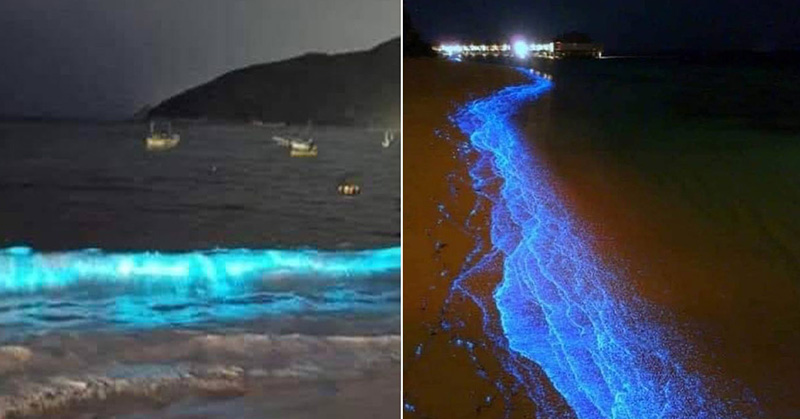Imagine the beauty of the Northern Lights combined with the romanticism of a beach at night. Although that sounds like something from Fantasia, this magical event has occurred for the first time in 60 years. Mexican residents walking along the Puerto Marqués beach in Acapulco saw the shore light up with bioluminescence on the 20th of April. This magical blue glow happens as a result of a biochemical reaction from the bioluminescent planktons who live in the water.
A Natural Light Show at Puerto Marqués Beach
Some people who posted the phenomenon on social media believe the presence of the bioluminescent planktons is due to the lack of people around the area as a result of the current pandemic. Marine biologist Enrique Ayala Duval was quick to explain the true cause behind the event.
On Sabersinfin.com, he wrote, “Bioluminescence is the light produced as a result of a biochemical reaction in which most of the time luciferin [protein], molecular oxygen and ATP [adenosine triphosphate] take part, which reacts by means of the enzyme luciferase in the following way: oxygen oxidizes luciferin, luciferase accelerates the reaction, and ATP provides the energy for the reaction, producing water and light, which is very noticeable at night.”
In other words, bioluminescence is a chemical reaction when microorganisms in the sea like fungi, bacteria, mollusks, are insects are disturbed by the oxygen in the waves, which causes them to emit blue light. [1]
Duval adds that the reason why bacteria produce light is unknown; however, some fish and squid do benefit from such light to attract prey, escape from predators, or communicate with mates.
One theory suggests that bioluminescence is a result of evolution. When Earth’s atmosphere had extremely little oxygen, it began to increase as the number of photosynthetic organisms grew, but before then, organisms were released from oxygen that was toxic for them, which created the bioluminescence in the water.
Ignoring the Beach Swimming Ban
Because of the coronavirus pandemic, Mexico has been in national lockdown, preventing anyone from going swimming at the beaches to prevent the virus from spreading. However, one man couldn’t resist the temptation of this once-in-a-lifetime marine light show and dove into the Pacific Ocean. The waves created from his jump into the water and the splashing from his swimming rippled with bright blue light, reminiscent of like Elsa using her sparkling ice magic in Frozen.
Many social media users did not approve of his decision. While they valued the natural phenomenon, they commented that human beings ruin everything.
On Facebook, Arturo Martinez blames motorists for the lack of bioluminescent plankton, after a conversation with his friend, Domitilio Soto, who told him that these microorganisms were often run over by tourists on ATVs.
Glowing Night Life in Mexico
Although this phenomenon has taken 60 years to reappear in Acapulco, it’s a common occurrence in other parts of Mexico.
The shore along the magical island of Holbox in Quintana Roo is lit up in blue from May to September. In the five lakes in Chacahua National Park in Chacahua, the romanticism is seen in Oaxaca between the months of August and March. [3] Some residents and tourists see this bioluminescence on the surface of a whale.
This may not be the only effect of people evacuating natural spaces. Empty beaches in Oaxaca invited crocodiles to the shores earlier in April. Crocs usually hide in the lagoon at La Vintimilla, but they were spotted for the first time in a long while exploring the beach. [4]
Other Occurrences of Bioluminescence
Recently, Patrick Coyne posted a video of a pod of dolphins that appeared to be glowing neon blue. In truth, it was the plankton in the water that was glowing as it’s being disturbed by the waves.
There’s a lesser-known creature called a siphonophore which belongs to a group of animals called Cnidaria, which includes hydroids, corals, and jellyfish. Siphonophores are made up of clear, often glowing gelatinous material that’s that can break under little force.
There’s also a beach in the Maldives, a popular vacation destination. Blooms of bioluminescent plankton come to shore in the warm water on an unpredictable schedule. Sometimes they can only be seen from far away depending on when the currents are strong enough to wash them to the beach. This occurs when the organisms — like phytoplankton and ostracod crustaceans — are stressed, either from the crashing waves or from being touched.
Did I mention there are also glowing turtles? Yeah, they’re a thing too.

